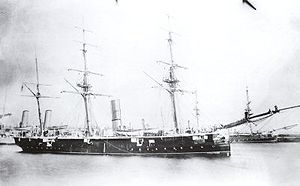Satellite class sloop
 HMS Satellite | |
| Class overview | |
|---|---|
| Name: | Satellite-class sloops |
| Builders: | Devonport Dockyard Sheerness Dockyard |
| Operators: | |
| Cost: | £62,900 (Satellite) - £71,000 (Caroline) (approx £5.25 million at 2008 prices) |
| Built: | 1883–1888 |
| In commission: | 1883–1947 |
| Completed: | 7 |
| General characteristics | |
| Displacement: | 1,420 tons |
| Length: | 200 ft (61 m) |
| Beam: | 38 ft (12 m) |
| Draught: | 15.7 ft (4.8 m)[1] |
| Installed power: | 1,400 hp (1,044 kW) |
| Propulsion: |
Horizontal compound expansion steam engine Single screw[1] |
| Sail plan: | Barque-rigged |
| Range: | Approximately 6,000 nmi (11,000 km) at 10 kn (19 km/h)[1] |
| Complement: | 170-200 |
| Armament: |
As designed:
|
| Armour: | Internal steel deck over machinery and magazines |
The Satellite class was a class of 12-gun composite sloops built for the Royal Navy between 1883 and 1888, and reclassified as corvettes in 1884.[2]
Contents
Construction
Design
Designed by Nathaniel Barnaby,[1] the Royal Navy Director of Naval Construction, the hull was of composite construction; that is, iron keel, frames, stem and stern posts with wooden planking. This class of composite sloops was unique in having an internal steel deck over the machinery and magazines for protection. The Satellite class were reclassified as corvettes in 1884, and no more composite or wooden corvettes were built - in fact, HMS Pylades was the last corvette built for the Royal Navy until the Second World War.
Propulsion
Propulsion was provided by a horizontal compound expansion of 1,400 indicated horsepower (1,044 kW) driving a single screw.
Sail Plan
All the ships of the class were built with a barque rig.
Armament
The class was designed with two 6-inch/100-pounder (81cwt) Breach-Loaders and ten 5-inch/50-pounder (38cwt) Breech Loaders, plus a single light gun and four (or more) machine guns.[1] Heroine, Hyacinth and Royalist were built with eight 6inch/100-pounder (81cwt) Breach-Loaders in place of the 5-inch/6-inch mixture, and Satellite was converted to the same fit.[1]
Ships
| Name | Ship Builder | Launched | Fate |
|---|---|---|---|
| HMS Satellite | Sheerness Dockyard | 13 August 1881 | RNVR drill ship at North Shields on the River Tyne[3] in 1904. Sold to J G Potts for breaking on 21 October 1947 |
| HMS Heroine | Devonport Dockyard | 3 December 1881 | Sold to King of Bristol for breaking on 28 August 1902 |
| HMS Hyacinth | Devonport Dockyard | 20 December 1881 | Sold to King of Bristol for breaking on 25 August 1902 |
| HMS Royalist | Devonport Dockyard | 7 March 1883 | Hulk in February 1900. Renamed Colleen on 1 December 1913 and transferred to the Irish Free State Government on 19 February 1923 |
| HMS Rapid | Devonport Dockyard | 21 March 1883 | Hulk in 1906. Became a coal hulk in 1912 and was renamed C7. Became an accommodation ship in 1916 and was renamed Hart. Sold at Gibraltar in 1948 |
| HMS Caroline | Sheerness Dockyard | 25 November 1882 | Hulk in 1897. Became a training ship in April 1908 and was renamed Ganges. Renamed Powerful III in September 1913 and Impregnable IV in November 1919. Sold on 31 August 1929 |
| HMS Pylades | Sheerness Dockyard | 5 November 1884 | Sold to Cohen of Felixstowe for breaking on 3 April 1906. |
Operational Lives
These ships were designed to patrol the far-flung reaches of Britain's maritime empire, and so Rapid and Royalist both went to the Australian Station, Satellite to the Pacific Station, Pylades to the North America and West Indies Station and Heroine, Caroline and Hyacinth all to the China Station.[4]
See also
 Media related to Satellite class sloop at Wikimedia Commons
Media related to Satellite class sloop at Wikimedia Commons
References
- Colledge, J. J.; Warlow, Ben (2006) [1969]. Ships of the Royal Navy: the complete record of all fighting ships of the Royal Navy (Rev. ed.). London: Chatham. ISBN 9781861762818. OCLC 67375475.
- ↑ 1.0 1.1 1.2 1.3 1.4 1.5 1.6 1.7 Winfield, Rif; Lyon, David (2003). The Sail and Steam Navy List, 1815-1889. Chatham Publishing. ISBN 978-1861760326.
- ↑ 2.0 2.1 "Satellite-class sloops at Battleships-Cruisers website". http://www.battleships-cruisers.co.uk/satellite_class__sloops.htm. Retrieved 2008-09-11.
- ↑ Shore Establishments of the Royal Navy (Being a list of the Static Ships and Establishments of the Royal Navy) by Lt Cdr Warlow RN (1992), Maritime Books, Liskeard ISBN 0907771521
- ↑ "Naval Database website". http://www.pbenyon.plus.com/18-1900/Index.html. Retrieved 2008-09-10.
| ||||||||
